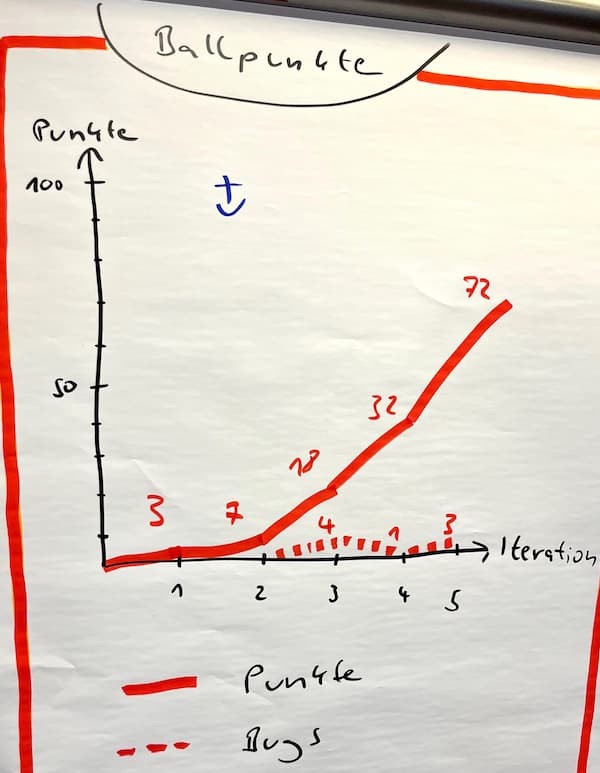In some of my trainings, we play the Ball Point Game.
Participants form teams and pass balls to each other – following a set of simple rules – to score as many points as possible.
At first, they experiment, improve slightly – and are quickly quite satisfied.
Then they hear that other groups have achieved ten times as many points.
Some teams take this as motivation and begin to completely rethink their approach: “What would we have to change to get there?”
Others don’t believe it – or stick to their current way of working.
We’ve played this game with hundreds of groups and are very familiar with this social dynamic:
The acceptance or rejection of the idea of tenfold productivity – this mental anchor, which is often hard to imagine at first – has a major influence on a team’s later performance.
The teams that accept the anchor achieve significantly more.
Some come close to the 10x target or even reach it.
That usually takes several attempts – and some of them fail.
But the teams that reject the idea that “10x is possible” tend to improve very little.

The “anchor” marks the moment when participants hear that achieving 10 times more is indeed possible.
I believe that we as a society may currently be at a similar anchor point with artificial intelligence.
At the same time, there’s so much hype that I initially approached the topic with considerable skepticism – and some of that skepticism is definitely justified.
Between Excitement and Skepticism
This week, Timon forwarded me a compelling blog post by Harper Reed. In it, he describes his personal learning journey with AI tools in software development – across nine stages.
He starts with basic prompts and ends up with a setup where he runs 3–5 parallel AI sessions, switching between terminals – watching the AI write code.

In his conclusion, he writes:
“Nobody can see this because they didn’t go through the journey to get here. But those who have are agreeing and sharing their own tips around the journey, and debating the destination.
Do I believe him?
Well – I consider Harper to be an experienced software expert with a long online history. He’s always been involved with emerging technologies, speaks publicly on these topics, and advises companies. Yes, he clearly has a business interest in presenting this as a revolutionary moment.
But his contributions and references – especially as someone who actually practices what he writes about – come across as fundamentally credible and relatable.
Henrik Kniberg – known to many from his “PO in a Nutshell” video – has also shared how AI is changing his work. In a recent post, he’s seen eating fresh strawberries while an AI codes for him.

And then this line from him:
“My productivity doubled five times – that’s a 32x increase.”
That sounds impressive – almost too good to be true.
And Henrik, too, has a business interest in the AI hype: He co-founded a company that provides AI agent infrastructure for organizations.
At the same time, I find him to be a trustworthy person – someone I watched live just two weeks ago at the closing keynote of the Global Scrum Gathering in Munich. There, he had an AI build a small new feature on his live platform with paying customers – while he discussed the future of AI with the audience.
There is a very real tension when it comes to working with AI:
- Some results – even from experienced users – are not high quality.
- Often, it produces large volumes of mediocre content that can dilute rather than raise the bar. In content-heavy domains (like blogs), this can even do harm when volume outweighs value.
- And: The less I know about a subject, the more amazed I tend to be by the first usable results.
This can lead to pressure, tension, and misunderstandings – especially between domain experts and their managers
Still, I believe: AI is here to stay.
Much like the internet in the 90s – overhyped at first, yet impossible to ignore today.
And when you learn how to use it properly, it can truly multiply productivity. At the very least, we should give this possibility a real chance – and be willing to accept this anchor point.
What I’m working on
Right now, I’m learning a lot from developers about how they use AI in their daily work – and I’m experimenting with how AI can support product management and leading teams and organizations.
For example: in structuring requirements, writing more clearly, identifying issues from messages, and slicing.
I also find the potential of fast documentation and easier processing of input from many stakeholders or workshop participants incredibly promising for facilitation of work with larger groups.
If that sounds interesting to you – or if you’re on a similar path – feel free to reach out. I’d love to exchange thoughts and let you know once something more concrete takes shape.